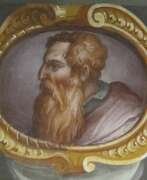Decorators 16th century


Amico Aspertini was an Italian Renaissance painter, draughtsman, and sculptor, considered one of the leading representatives of the Bolognese school of painting.
He was trained in the family workshop and was influenced by the artists of the Ferrara school, Ercole de'Roberti, Lorenzo Costa, and Francesco Francia. He worked as a painter and sculptor, and was also an excellent draughtsman, as evidenced by his many surviving drawings and sketches. Contemporaries marveled at his complex and impulsive character and noted that he worked with both hands simultaneously.
Aspertini painted splendid portraits as well as numerous frescoes and altarpiece paintings in chapels and churches in Italy. Many of his works are eccentric and eclectic, even whimsically fantastical, his complex style anticipating Mannerism.


Pedro de Raxis was a Spanish painter and gilder known for his contributions to the Granadan school of art. Born in 1555 in Alcalá la Real, Jaén, Raxis became a key figure in Granada art of the Counter-Reformation era. Characterized by vivid narrative and Mannerist influences, his works are characterized by intense, luminous colors and delicate composition.
Raxis's career was marked by numerous significant commissions. Among his best-known works are the murals for the church of San Cecilio in Granada (1580), the retablos of Santa María Mayor de Alcaudete (Jaén) and Asunción de María in Granada Cathedral (1615). These works demonstrate his exceptional skill in estofado, a technique involving the gilding and polychroming of statues and altarpieces.
One of Raxis's most famous works is Aparicion de la Virgen a San Jacinto, preserved in the Granada Museum of Fine Arts. This painting, dating from around 1600, represents a significant achievement in Raxis's artistic journey. It illustrates the mystical ecstasy and contemplative rapture characteristic of Spanish Baroque culture. The expressive depth and rich tonal range of the painting became more evident after its restoration in 1998.
Pedro de Raxis's influence extended beyond his paintings. Contemporaries such as Francisco Pacheco praised his mastery of estofado and gilding. Raxis established one of the most prolific and versatile workshops in Granada, which left an indelible mark on the artistic landscape of Andalusia.
For collectors and art experts, Raxis' work remains a testament to the rich cultural heritage of the Granada school. His paintings not only reflect the artistic fervor of the era, but also provide a glimpse into the religious and cultural world of Counter-Reformation Spain.
To delve deeper into the world of Pedro de Raxis and to keep up to date with new sales and auction events related to this master of the Granada School, subscribe to our updates. Our subscription will keep you up to date with the latest offers and events.


Benvenuto di Giovanni di Meo del Guasta, an Italian painter hailing from Siena, was recognized for his compelling panel paintings, frescoes, and manuscripts produced over a span of 43 years, during the Renaissance period. Born around 1436, his work life was largely based in Siena, where he was first documented as a young artist in 1453. His teacher was likely Vecchietta, with whom he collaborated on fresco decoration in Siena's baptistry. Di Giovanni married Jacopa di Tommaso da Cetona in 1466, which marked the beginning of a productive period that saw the creation of notable works such as the Annunciation and Saints (1466) and the Nativity (1470).
Benvenuto di Giovanni's style was characterized by its noble, classical forms and bright, intensely lit, glassy consistency, influenced by his interaction with North Italian miniaturists like Liberale da Verona and Girolamo da Cremona. His works, such as the triptych from Montepertuso (1475), the Borghesi altarpiece, and the triptych in the National Gallery, London (1479), stand as masterpieces of his sharply defined and surreal world. In the later years of his career, di Giovanni was commissioned for floor designs in the Siena cathedral and miniatures for its choir books, showing a style that occasionally simplified due to collaboration with his son, Girolamo di Benvenuto, but remained distinctively his.
Significant works by Benvenuto di Giovanni include "The Adoration of the Magi" and "The Crucifixion," both showcasing his mastery in perspective and religious narrative. For collectors and experts in art and antiques interested in the evocative and historically rich works of the Renaissance, Benvenuto di Giovanni's oeuvre offers a captivating exploration of 15th-century Sienese artistry.
To stay updated on sales and auction events featuring works by Benvenuto di Giovanni, sign up for updates. This subscription ensures that enthusiasts and collectors are always informed about new opportunities to engage with the exquisite works of this renowned Renaissance artist.


Hans Vredeman de Vries was a Netherlandish painter and printmaker, decorative artist, architect and Renaissance engineer.
After studying the works of Vitruvius and Sebastiano Serlio and putting in a great deal of labor himself, Vredeman became known throughout Europe as a specialist in perspective. As an architectural theorist, he was most famous for his varied designs of invented views of cities and buildings shown in carefully considered linear perspective. These were apparently created as models for architects.
In 1575-1586 Hans Vredeman de Vries was appointed city architect of Antwerp and was responsible for the fortifications of the city. He then worked in Hamburg, Danzig, Prague and Amsterdam. He is also known for his 1583 publication on garden design and books with many examples of ornamentation and perspective.
His son Salomon Vredeman de Vries (1556-1604) was also an artist.























